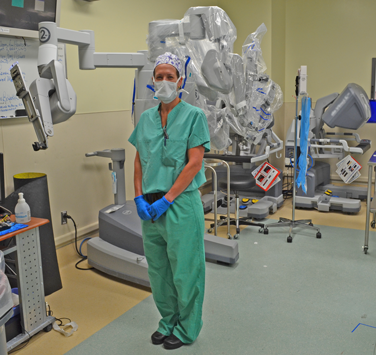Minimally Invasive & Robotic Surgery
Minimally invasive & robotic surgery at a glance
-

CU minimally invasive robotic surgeon in front of the “tower,” or the robotic arms that go over the patient during the operation. Minimally invasive surgery uses very small tools and cameras inserted into small incisions to diagnose and treat pelvic conditions.
- Robotic surgery, using a computer to control robotic tools, is often performed in conjunction with minimally invasive procedures to allow the surgeon greater precision.
- Laparoscopy and hysteroscopy are the two most common forms of minimally invasive surgery for pelvic conditions.
- The availability of robotic-assisted surgery depends on the facility and the doctor’s experience.
What is minimally invasive & robotic surgery?
Minimally invasive surgery
Minimally invasive procedures are an alternative option to open surgery. The surgeon uses small scope devices and tools to view and operate internally on the pelvis, abdomen, uterus and other organs.
The scope and other tools used with minimally invasive surgery allow the doctor to make minimal
incisions, which leave smaller scars, reduce the chance of clotting or infection, lessens post-surgery pain, and decrease recovery time compared to traditional surgery.
Minimally invasive surgery can often be performed as an outpatient procedure, meaning the patient gets to go home within the same day, as opposed to staying several days at the hospital to recover.
Robotic surgery
Robotic surgery is often used in combination with minimally invasive procedures to provide the doctor greater precision and flexibility during surgery, especially when removing growths or correcting problems in the pelvic area.
Performing robotic surgery requires extensive specialized training. The surgeon uses a computer system to control robotic surgical tools, including tiny cameras to view the internal structure of the pelvis, abdomen and uterus.
Types of minimally invasive surgery
Minimally invasive surgery can be performed to remove uterine fibroids, ovarian cysts, and pelvic adhesions. It also can be performed for tubal ligation (“getting your tubes tied”), tubal ligation reversal, hysterectomies, endometriosis removal, and addressing other pelvic problems.
Laparoscopy
An instrument called a laparoscope is inserted into the abdomen through a small incision to allow the surgeon to view the abdomen and its organs.
In order to insert the tools, the surgeon makes a quarter- to a half-inch incision under the belly button and up to three more similarly sized incisions at the belly’s hairline.
Hysteroscopy
An instrument called a hysteroscope is inserted through the vagina and cervix into the uterus to give the doctor a view inside of the uterus.
Because a hysteroscopy is performed through natural body openings (the vagina and cervix), it does not require any incisions, and so does not leave any visible scars.
Risks
Minimally invasive surgery is not always the best solution for all conditions – open surgery will sometimes be the more effective option. Additionally, patients who are obese or who have had previous open surgery in the abdomen are not considered good candidates for minimally invasive procedures.
Whether or not minimally invasive surgery is available depends on the doctor’s experience and the facility having the correct equipment.
Robotic surgery may be performed for minimally invasive or open surgery. However, the availability of the robotic computer system and tools at the hospital or facility, as well as the doctor’s ability to operate the computerized controls, will determine if robotic-assisted surgery can be performed.
